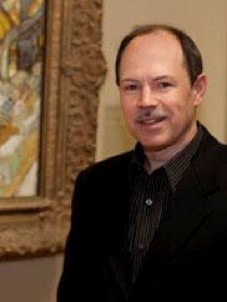
- William H. Robinson
The Cleveland Museum of Art
Curator of Modern European Art
Department Head, European and American Painting & Sculpture
Meet the Board: William H. Robinson
Please start by telling us about where you work and what you do there.
I am the Curator of Modern European Art and Head of the Department of European and American Painting and Sculpture at the Cleveland Museum of Art. My most important responsibility is overseeing the care of the museum’s collection of European painting and sculpture from 1800 to 1960. This includes working closely with our conservation department, conducting research and writing catalogues, articles, gallery texts, and other interpretative materials. I also organize exhibitions and propose new acquisitions in my area.
What is your earliest museum memory?
My earliest museum experiences occurred during my childhood when my family was living in Europe. Among the most unforgettable experiences from this period are visiting Fort Douaumont at Verdun and the surrounding cemeteries and battle site. Besides touring the Louvre and other art museums, we also visited numerous historic sites, including cathedrals, medieval castles, and the ruins of Oradour-sur-Glane, site of an infamous Nazi atrocity and a local museum.
What led you to go into the museum field?
A combination of a lifelong interest in the arts and a deep fascination with the relationship between arts, the general history of civilization and individual human psychology. I began studying art history as an undergraduate and decided to continue at a graduate school level, but was faced with a choice between either becoming an academic or working in museums. It was my love of discovering new knowledge found in original documentary materials, together with a deep attachment to great works of art, which prompted me to choose a museum career and work with objects.
What is your workspace like?
My office has a desk, a filing cabinet, two book shelves and windows with a beautiful view of the small park on the north side of the museum.
What item in your office can you not live without?
My computer and my iPhone.
Describe your favorite work memory. What was your best day like?
Perhaps the opening of “Transformations in Cleveland Art,” an exhibition I co-organized that examined the history of art in northeast Ohio. The opening was incredibly poignant because I had spent years working with artists and their families to reconstruct hundreds of stories that needed to be told more completely, and in many cases, to bring public attention to absolutely fantastic work that had long been overlooked. The opening was jam-packed with the friends and families of these artists, and their warmth and deep appreciate of what we had accomplished was so moving that I could barely speak when asked to address a large crowd of people who had become close friends.
What does your dream museum look like?
This is an impossible question to answer because I love so many different types of museums: art museums, history museums, science museums, historic sites, etc. Each has a different function and purpose, and is uniquely configured to address the needs of a wide variety of missions and audiences. They are wonderful: large and small, old and new, private homes and grand structures.
What is the best advice you have ever received?
Nothing is every complete or perfect. Do not try to write the definite work on a subject because you will always make subsequent discoveries, just consider it one chapter in a longer, evolving book, and believe in serendipity.
What are you currently reading?
I also read broadly, not just in my area of academic specialization. Besides reading about artists, Freud and psychoanalysis, I have been reading Joseph Stiglitz’s The Price of Inequality, James Loewen’s Lies My Teacher Told Me, and Steven Waldman’s Founding Faith.
Is there anything else you would like to add?
Museums are fantastic, wonderful places, please visit.